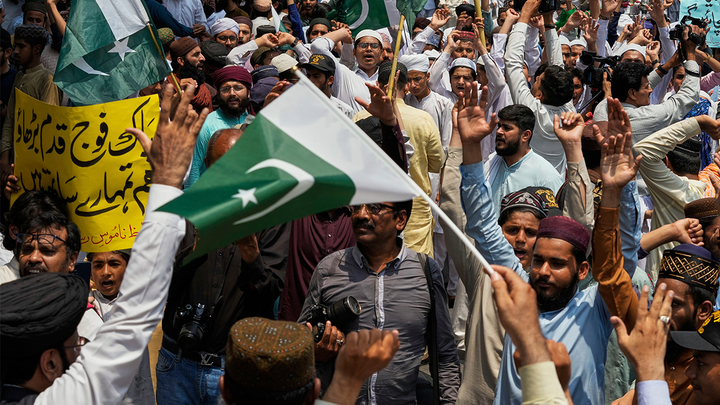The May conflict between India and Pakistan brought Chinese weaponry, particularly the J-10C fighter jet, into the global spotlight, as Pakistan used Chinese arms to shoot down Indian aircraft in a rare, real-world test of their battlefield effectiveness. This unexpected validation has boosted Chinese arms sales, strengthened China's defense ties with countries like Pakistan and Indonesia, and expanded Beijing’s geopolitical influence in South Asia at the expense of declining Western engagement.

Supporters of a religious group "Tahafuz-e-Namoos-e-Risalat Mahaz" take part in a rally to condemn Indian strikes in Pakistan and to show their support with Pakistan Army, in Lahore, Pakistan, Saturday, May 10, 2025. (Photo: AP)
The armed conflict between Pakistan and India that took place during the second week of May thrust Chinese weaponry into the global spotlight. During the dispute, Pakistan used Chinese-manufactured J-10C jets to shoot down Rafale planes operated by India. The three-day-long battle unexpectedly became a showcase for the effectiveness of Chinese arms.
The May conflict was triggered by a militant attack in Pahalgam, in Indian-administered Kashmir, on April 22, where 26 tourists were brutally killed by unidentified assailants. India quickly jumped the gun and blamed Pakistan for the attack without offering concrete evidence, a claim Pakistan firmly denied..
India initially responded by unilaterally holding in abeyance the Indus Waters Treaty (IWT) with Pakistan. The IWT regulates the distribution of the waters of six rivers in the Indus basin between the two countries. Pakistan reciprocated by closing down its airspace for Indian origin airplanes. Both countries declared dozens of each other’s diplomats “persona non grata” and expelled them. However, this was by no means the end of the conflict.
On May 7, India launched Operation Sindoor and attacked, what it called, terrorist camps at nine locations in Pakistan. On May 10, Pakistan responded with Operation Bunyan-un-Marsus and launched attacks on 26 sites in different parts of India. The cross-border fighting left 51 dead on the Pakistani side and at least 16 killed on the Indian side. The conflict ended on the evening of May 10, after a ceasefire was agreed between India and Pakistan, brokered by the United States. This marked the first time since 1971 that both countries crossed international borders to attack one another. In contrast, the conflicts of 1999 and 2019 were confined to the disputed territory of Kashmir.
A defining moment of this armed conflict was the air battle between the Pakistan Air Force (PAF) and the Indian Air Force (IAF) in the early hours of May 7. India launched attacks inside Pakistan with the help of its fighter jets, notably Rafales, MiG-29, and SU-30. In response, Pakistan counterattacked with Chinese-made J-10C jets, engaging Indian jets from within its own airspace. Pakistan claimed to have shot down five Indian jets, including three Rafales. Western sources confirmed the downing of at least two Indian jets, one of them being a French-made Rafale.
This air battle thrust Chinese-manufactured jets into the spotlight. The J-10C, or Chengdu J-10, is a medium-weight, single-engine, multirole combat aircraft produced by Chengdu Aircraft, which is a subsidiary of the Chinese state-owned Aviation Industry (AVIC). Outside of the People's Liberation Army Air Force and Naval Air Force, this jet is solely used by the Pakistan Air Force (PAF).
In 2020, Pakistan reportedly ordered 36 J-10CEs, the export version of the J-10C, together with 250 PL-15 [export version] missiles from China. The first batch of six planes was delivered in 2022, and to date, 20 J-10Cs are in service in the PAF. The PAF used both PL-15 missiles from J-10C jets to shoot down Indian jets. The HQ-9 air defense system, also produced by China, was deployed by Pakistan to counter Indian missile strikes as well.
The over-reliance by Pakistan on Chinese arms is not surprising, as China is the largest arms supplier to the country. According to Stockholm International Peace Research Institute (SIPRI), 63% of all Chinese arms exported from 2020-24 were procured by Pakistan. During the same period, 81% of all arms imported by Pakistan came from China. Since the 1990s, following arms embargoes by the U.S. and other Western countries, Pakistan has increasingly turned to China for its defense procurement.
The Indo-Pak conflict offered a rare, real-time test of Chinese arms, long criticized for lacking battlefield validation, altering the perception of their effectiveness at the global level. This was also reflected in the performance of the stock of Chinese companies. The stock price of Avic Chengdu Aircraft Co Ltd, manufacturer of J-10C, increased by over 36% in just two days after the fighter jets' battle, indicating increased confidence of shareholders.
Moreover, the success of J-10C has also generated demand for the aircraft. The Indonesian Air Force has expressed interest, making it the first of many potential buyers. Meanwhile, Pakistan is considering the purchase of China’s fifth-generation stealth fighter. The Pakistani government has reportedly agreed to acquire Chinese J-35 fighter jets, with the deal currently underway. . If finalized, the inclusion of J-35 will further bolster the strength of PAF in its future conflicts with IAF. This means that the recent Indo-Pak jet battles have served as an unintended marketing campaign for Chinese arms, boosting their international sales.
Furthermore, these developments suggest that Chinese arms will become the primary choice for many developing countries that are unable to procure weapons from Western countries due to political and economic constraints. Pakistan will be at the top of the list of such countries, ramping up its purchases from China to reinforce its defenses against any potential future aggression from India. At the same time, China’s geopolitical influence will grow in South Asia as American clout decreases, particularly with President Trump’s moves to gut USAID and the State Department. In short, China turned out to be the unexpected winner of the Indo-Pak conflict of May.
